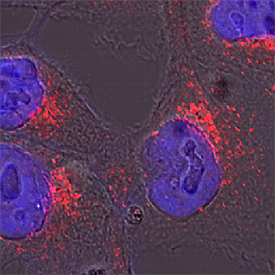Human/Mouse Golgi Glycoprotein 1/GLG1 Antibody Summary
Lys1048-Asn1145
Accession # Q92896
Applications
Please Note: Optimal dilutions should be determined by each laboratory for each application. General Protocols are available in the Technical Information section on our website.
Scientific Data
 View Larger
View Larger
Detection of Human and Mouse Golgi Glycoprotein 1/GLG1 by Western Blot. Western blot shows lysates of MCF-7 human breast cancer cell line and Hepa 1-6 mouse hepatoma cell line. PVDF membrane was probed with 2 µg/mL of Mouse Anti-Human/Mouse Golgi Glycoprotein 1/GLG1 Monoclonal Antibody (Catalog # MAB78791) followed by HRP-conjugated Anti-Mouse IgG Secondary Antibody (Catalog # HAF018). A specific band was detected for Golgi Glycoprotein 1/GLG1 at approximately 150 kDa (as indicated). This experiment was conducted under reducing conditions and using Immunoblot Buffer Group 1.
 View Larger
View Larger
Golgi Glycoprotein 1/GLG1 in HeLa Human Cell Line. Golgi Glycoprotein 1/GLG1 was detected in immersion fixed HeLa human cervical epithelial carcinoma cell line using Mouse Anti-Human/Mouse Golgi Glycoprotein 1/GLG1 Monoclonal Antibody (Catalog # MAB78791) at 25 µg/mL for 3 hours at room temperature. Cells were stained using the NorthernLights™ 557-conjugated Anti-Mouse IgG Secondary Antibody (red; Catalog # NL007) and counterstained with DAPI (blue). Specific staining was localized to cytoplasm. View our protocol for Fluorescent ICC Staining of Cells on Coverslips.
Reconstitution Calculator
Preparation and Storage
- 12 months from date of receipt, -20 to -70 °C as supplied.
- 1 month, 2 to 8 °C under sterile conditions after reconstitution.
- 6 months, -20 to -70 °C under sterile conditions after reconstitution.
Background: Golgi Glycoprotein 1/GLG1
GLG1 (Golgi complex-Localized Glycoprotein 1), also known as CFR1, E-Selectin Ligand-1/ESL-1, MG-160 and Cys-rich FGF Receptor, is a 150-160 kDa (reducing; 130 kDa nonreducing) glycoprotein. It is expressed in both Golgi and/or the cell membrane of multiple cell types, including neutrophils (from rodents; not humans), liver stellate cells, neurons, cardiac myocytes, monocytes and bronchial epithelial cells. In the blood, GLG1/ESL-1 collaborates with PSGL-1 to mediate leukocyte binding to endothelial cell surfaces. PSGL-1 initiates leukocyte tethering while GLG1 promotes slow rolling. GLG1 also serves as an intra-Golgi receptor for multiple FGFs, including FGF-1, -2, -4, -18 and possibly -3, and as a component of an unusual latent TGF-beta complex. Mature human GLG1 is an 1150 amino acid (aa) type I transmembrane protein. It contains a 1116 aa extracellular/luminal region (aa 30-1145) plus a short 13 aa cytoplasmic segment. The extracellular region possesses a 16 aa poly-Gln segment followed by 16 Cys-rich repeats (aa 116-1101). There are three potential isoform variants, one of which possess a 24 aa extension at the C‑terminus, a second that couples the aforementioned C‑terminal extension to a deletion of aa 147-157, and a third that contains a 14 aa substitution for aa 685-1179. It is suggested that the longer C‑terminus retains GLG1 in the Golgi, while shorter cytoplasmic segments allow for presentation at the cell membrane. Over aa 1048‑1145, human and mouse are identical in aa sequence.
Product Datasheets
FAQs
No product specific FAQs exist for this product, however you may
View all Antibody FAQsReviews for Human/Mouse Golgi Glycoprotein 1/GLG1 Antibody
There are currently no reviews for this product. Be the first to review Human/Mouse Golgi Glycoprotein 1/GLG1 Antibody and earn rewards!
Have you used Human/Mouse Golgi Glycoprotein 1/GLG1 Antibody?
Submit a review and receive an Amazon gift card.
$25/€18/£15/$25CAN/¥75 Yuan/¥2500 Yen for a review with an image
$10/€7/£6/$10 CAD/¥70 Yuan/¥1110 Yen for a review without an image

